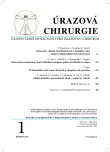Osteosynthesis zygomaticomaxillary komplex fracture 1-3-point fixation
Published in:
Úraz chir. 24., 2017, č.1
Overview
AIM OF THE STUDY:
Treatment of zygomaticomaxillary complex fractures by osteosynthesis is considered a standard method, however, there still exists a debate over the number and location of osteosynthesis plates used in the treatment among the professional circles. The aim of the study was to assess the 1-3-point fixation of zygomaticomaxillary complex fractures in clinical practice.
MATERIAL AND METHODS:
A total of 45 patients with isolated zygomaticomaxillary complex fractures treated with osteosynthesis were enrolled in the 5-year study; the patients underwent a total of 81 osteosyntheses. Of that, there were 69 osteosyntheses from the extraoral approach, and 12 from the intraoral approach. Evaluation was based on postoperative CT scans used to compare to the volume of the operated and the healthy orbit.
RESULTS:
In our sample, a total of 81 osteosyntheses were performed in 45 patients; 1-point fixation was used in 10 cases, 2-point fixation in 34 and 3-point fixation in one case only. Comparison of the orbital volume on the side of the operation and the healthy one in all groups showed almost identical results; the sample of patients with 3-point fixation, consisting of one patient only was not sufficient to perform the statistical processing of the results.
CONCLUSION:
Assessment of our patient file did not confirm the need for 3-point fixation in the treatment of isolated fractures of the zygomaticomaxillary complex, and proved the 1-2-point fixation being fully sufficient. Even the 1-point fixation, when performed after adequate reduction, is fully sufficient in the clinical practice, and is associated with good results.
KEYWORDS:
Zygomaticomaxillary complex fracture, osteosynthesis, 1-3-point fixation.
Sources
1. BENTLEY, F., SGOUROS, S., NATARAJAN, K. et al. Normal changes in orbital volume during childhood. J Neurosurg. 2002, 96, 742–746. ISSN1933-0693
2. JI, HEUI, K., JUN, HO, L., SEOK, MIN, H. et al. The Effectiveness of 1-Point Fixation for Zygomaticomaxillary Complex Fractures. Arch Otolaryngol Head Neck Surg. 2012, 138, 828–832. ISSN 1472-6922
3. KNIGHT, JS., NORTH, JF. The classification of malar fractures: An analysis of displacement as a guide to treatment. Br J Plast Surg. 1961, 3, 325–329. ISSN 9623850
4. TRAVIS, TT., ARLEN, DM. Zygomaticomaxillary Complex Fractures Treatment & Management. www.emedicine.medscape.com 2017, 3.
5. www.uzis.cz
Labels
Surgery Traumatology Trauma surgeryArticle was published in
Trauma Surgery

2017 Issue 1
- Metamizole vs. Tramadol in Postoperative Analgesia
- Metamizole at a Glance and in Practice – Effective Non-Opioid Analgesic for All Ages
- Possibilities of Using Metamizole in the Treatment of Acute Primary Headaches
- Current Insights into the Antispasmodic and Analgesic Effects of Metamizole on the Gastrointestinal Tract
- Spasmolytic Effect of Metamizole
Most read in this issue
- ACUTE PERONEAL TENDON DISLOCATION – A COMPREHENSIVE REVIEW OF THE LITERATURE
- MID-SHAFT CLAVICLE FRACTURES IN ADULTS – ANALYSIS OF FAILURES AFTER PLATING
- Osteosynthesis zygomaticomaxillary komplex fracture 1-3-point fixation
- Specific treatment of gunshot´s and shrapnel´s injuries
